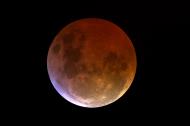What Are Eclipses?

Next Annular Solar Eclipse: Thu, Sep 1, 2016 … See animation
An eclipse is an astronomical event where one celestial body partially or totally covers another celestial object.

A partial solar eclipse.
The Moon covering parts of the Sun during a Partial Solar Eclipse.
©iStockphoto.com/Hans-Walter Untch
This happens when the eclipsing body comes between the observer and the eclipsed object like in the case of a solar eclipse, or when the eclipsing body temporarily cuts off the source of illumination of the eclipsed object, like during a lunar eclipse.
When a planet comes between the Earth and the Sun, and becomes visible as a black dot, it is called a transit.
Types of Eclipses
Eclipses and Transits 1900-2099
Observers from Earth can see two types of eclipses – eclipses of the Sun (solar eclipses), and eclipses of the Moon (lunar eclipses). These occur when the Sun, Earth and Moon align in a straight or almost straight configuration. Astronomers call this a syzygy, from the ancient Greek word syzygia, meaning to be yoked or conjuncted together.
The term eclipse also finds its roots in ancient Greek – it comes from the word ékleipsis, meaning to fail or abandoned.
Eclipses, solar and lunar, have fascinated scientists and lay people for centuries. In ancient times, eclipses were seen as phenomena to be feared – many cultures came up with stories and myths to explain the temporary darkening of the Sun or the Moon. In recent centuries, eclipses have been sought after by scientists and astronomers who use the events to study and examine our natural world.
Solar Eclipses
Solar eclipses can only occur during a new Moon, when the Moon moves between the Earth and the Sun and the three celestial bodies form a straight line: Earth - Moon - Sun.
There are 3 kinds of solar eclipses: total, partial, annular. There is also a rare hybrid that is a combination of two eclipses.
Total Solar Eclipses
All Total Solar Eclipses 1900-2099
A total solar eclipse occurs when the Moon completely covers the Sun, as seen from Earth. Totality during such an eclipse can only be seen from a very small area on Earth. This area is usually about 100 miles (160 kms) wide and 10,000 miles (16,100 kms) long. Areas outside this track may be able to see a partial eclipse of the Sun.
Looking at a solar eclipse without any protective eyewear can severely harm your eyes. The only way to safely watch a solar eclipse is to wear protective eclipse glasses or to project an image of the eclipsed Sun using a DIY Pinhole Projector.
Partial Solar Eclipses
All Partial Solar Eclipses 1900-2099
A partial solar eclipse can be observed when the Earth, Moon and Sun do not align in a perfectly straight line, and the Moon only partially covers the disc of the Sun.
Annular Solar Eclipses
All Annular Solar Eclipses 1900-2099
An annular solar eclipse occurs when the Moon appears smaller than the Sun as it passes centrally across the solar disk and a bright ring, or annulus, of sunlight remains visible during the eclipse.
Hybrid Solar Eclipses
A hybrid solar eclipse is a rare form of solar eclipse, which changes from an annular to a total solar eclipse along its path.
Lunar Eclipses

The Moon does not have its own light. It shines because its surface reflects the Sun's rays. A lunar eclipse occurs when the Earth comes between the Sun and the Moon and blocks the Sun's rays from directly reaching the Moon. Lunar eclipses only happen at full Moon.
There are 3 kinds of lunar eclipses: total, partial, and penumbral.
Total Lunar Eclipses
All Total Lunar Eclipses 1900-2099
A total lunar eclipse occurs when the Earth's umbra – the central, dark part of its shadow – obscures all of the Moon's visible surface.
Partial Lunar Eclipses
All Partial Lunar Eclipses 1900-2099
A partial lunar eclipse can be observed when only part of the Moon's visible surface is obscured by the Earth’s umbra.
Penumbral Lunar Eclipses
All Penumbral Lunar Eclipses 1900-2099
A penumbral lunar eclipse happens when the Moon travels through the faint penumbral portion of the Earth’s shadow.

Planet Transits
When a planet comes between the Earth and the Sun, it is called a transit. The only two planets that can be seen transiting the Sun from Earth are Venus and Mercury, because they are the only planets which orbit inside Earth's orbit.
From 2000–2099, there will be 14 transits of Mercury. However, Venus transits are even rarer with only two this century, in 2004 and 2012.
Next eclipse begins in
Sep 1, 2016 at 6:13 AM UTC … See more

Solar Eclipses
- Different Types of Eclipses
- What are Solar Eclipses?
- Total Solar Eclipses
- Partial Solar Eclipses
- Annular Solar Eclipses
- Solar Eclipses in History
- Solar Eclipse Myths and Superstitions
- Magnitude of Eclipses
Eclipse Lookup

Protect Your Eyes
- Never look directly at the Sun
- Simple Pinhole Projector
- Eclipse Projector in a Box
- Binoculars / Telescope Projector

Lunar Eclipses
- Total Lunar Eclipse
- When is the Moon Red?
- Partial Lunar Eclipse
- Penumbral Lunar Eclipse
- Can I See a Lunar Eclipse?
- Blood Moon - Total Lunar Eclipse
- Magnitude of Eclipses
Eclipse Calculator w/ Animation
Moon Phases In Your City

Planet Transits
Moonrise & Moonset Times
Sunrise & Sunset Times
Weather Look-Up
Day & Night World Map App

Watch daylight move across the planet... More








Share this page / Follow us on:
Visit us on: